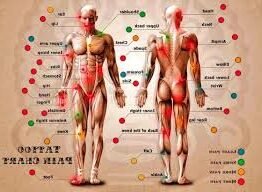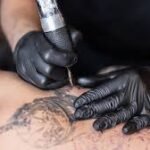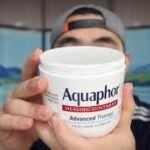Getting inked will hurt—that’s inevitable. But how much pain you feel depends on three key factors: tattoo placement, your personal tolerance, and your artist’s technique. Areas with little fat, thin skin, or many nerve endings (like ribs or hands) tend to be most painful, while spots with thickest skin and fewest nerve endings (like forearms) are least painful. As a tattoo artist, I’ve seen clients handle the same location completely differently—some wince at shading, while others nap through linework.
Your tattooing experience isn’t just about pain levels—it’s about preparation. A good session starts with a client who’s well-rested, hydrated, and mentally ready. I always communicate clearly with first-timers, giving them a realistic estimate of what to expect. The tattooing process involves a sharp needle piercing your top layer of skin to deposit pigment, which sounds scarier than it is. Surprisingly, bony areas (like collarbones) often hurt less than expected if the artist’s technique is gentle.
This comprehensive guide isn’t about scaring you—it’s about informed decisions. Your body part choice dramatically affects pain, but so does your individual pain tolerance. I’ve tattooed marathon runners who needed breaks and desk workers who sat like statues. The world of tattoo pain varies wildly, but knowing this outline helps you prepare for a more enjoyable tattooing experience.
Tattoo Pain Scale: How Bad do Tattoos Hurt?
While there’s no science-backed data to prove exactly where tattoos cause the most pain, years of tattooing clients (and getting inked ourselves) have helped create a pretty good pain map. Generally, body parts with less fat and muscle, lots of nerve endings, and thin skin near bone tend to be the most painful areas to get tattooed—think ribs or ankles versus the upper arm.
Everyone’s personal pain scale differs, but most people describe the sensation as a sharp, stinging pain. If you have sensitive skin, choosing an area with fewer nerve endings (like the outer arm) will make the experience less painful than more sensitive spots (like the inner arm). The individual experience varies, but this estimate helps set realistic expectations before your session.
Areas that Have the Most Nerve Endings
Your nerve endings are what sense pain and pressure, sending sharp signals straight to your brain—and in certain areas with more of these nerves, the pain becomes significantly more severe. From experience, I can confirm spots like the groin, fingertips, arch of the foot, shin, and back of the knee consistently rank in the most painful tattoo spots, often landing in the red and orange zones on pain charts. If you’re wondering where you’ll find the toughest areas to sit through, these zones below should be your warning.
Areas That Have Few Nerve Endings
If you’re nervous about the sharp, stinging pain of a tattoo, target areas like your upper back, outer shoulders, and thighs—these spots have the fewest nerve endings and thicker skin, making it easier to sit through the process. In my experience, these zones consistently rank in the yellow and green sections of any reliable tattoo pain chart, offering a much more manageable experience compared to more sensitive areas.
How Past Experiences Affect Your Mental Pain Threshold
Your past tattoo pain experience can affect your whole mentality about getting inked again—for example, if your first tattoo was on your ribs (with thinner skin), you might never want to sit through another session. But a client who gets tattooed in areas with few nerve endings, only dealing with mild burning pain for an hour, is likely to get more tattoos. It’s fascinating how that initial hurt shapes a person’s pain tolerance moving forward.
Rating the Body Parts From the Most to Least Painful Places
Every client asks how much a tattoo hurts, and while I can’t feel it for them, this cheat sheet helps explain what to expect. We rank body parts by relative pain levels – from most painful (like ribs with thin skin) to least painful (fleshy areas like thighs). But remember, these rankings are just a general guide – your individual pain tolerance will vary wildly. In my years of tattooing, I’ve seen tough guys sweat through forearm pieces while petite clients breeze through back tattoos. The key is understanding your area choice impacts the experience more than needle size or section duration
a. Most Painful Areas
The most painful spots to get tattooed are typically the areas your body naturally protects – think ribs, armpits, and inner thighs (protected by your arms and opposite legs). These zones combine multiple pain factors: they’re close to bones with little fat, have thin skin, and are packed with nerve endings. In my experience, clients describe the pain here as high to severe, especially during shading. While all tattoos involve some discomfort, these areas demand extra mental preparation – I always advise bringing a stress ball and scheduling shorter sessions for first-timers.
- If you’re wondering about the most painful spots for tattoos, the rib cage, sternum, and spine top the list—thin skin over bone equals sharp discomfort. The armpit and inner bicep are surprisingly tender due to nerve density, while the elbow, kneecap, and shin deliver a deep, vibrating ache. Sensitive areas like the areola, nipple, and groin make even seasoned tattoo lovers wince. Palms, soles, and fingers hurt more than expected because of tough skin and high nerve endings. And don’t underestimate the ankle, foot, or toe—small but brutal. Personally, the neck and behind the knees were my toughest sits—tingly, burning pain that tests patience.
b. Moderately Painful Areas
While these areas are more manageable than bony zones, they’re still sensitive – I’ve had clients describe the sensation like a persistent cat scratch on sunburned skin.
- The Spine and Hips (both 7.5) deliver a sharp vibration, while Face, Neck, and Lips surprisingly score the same – I’ve seen tough guys flinch when the needle hits those Ears; Hands, Knuckles, and Feet (7) feel like constant papercuts, whereas Calves and Stomach (6.5) offer dull throbbing; the Inner Bicep (6)?
c. Least Painful Areas
While clients consistently report the least amount of pain in certain areas – typically fleshy spots with more muscle or fat – let me give you an important reminder from my 8 years in the industry: no tattoo is completely painless; that buzzing sensation always finds a way to keep you honest, even in these so-called “easy” zones.
- For first-timers, the outer thigh and calf offer cushioning that dulls the sting (rated 5), while the forearm (4) and back (3) – with their meatier areas – feel more like persistent cat scratches than sharp pain; personally, I always recommend the upper arm or shoulder for initial tattoos since the Outer Bicep’s density makes even longer sessions tolerable, though that chest piece might look tempting, it’s deceivingly more intense than these beginner-friendly zones.
Factors Affecting Your Level of Tattoo Pain
Getting inked? Your pain level depends on several factors. Age and skin condition matter—older skin tends to bruise more, while younger skin may handle the needle better. Your weight plays a role too; loose skin from weight loss or little body fat can make the session more painful. Surprisingly, a Trusted Source suggests that regular tattoo collectors develop a higher pressure pain threshold compared to first-timers. Understanding these details helps you anticipate the discomfort and plan accordingly. From my experience, placement and mindset also influence the level of pain experienced, so choose wisely!
Pain Tolerance
Your personal pain threshold plays a huge role in how you’ll handle a tattoo session—what’s uncomfortable for one person might be barely noticeable to another. Pain tolerance varies widely from individual to individual, and this significantly impacts your overall experience. Over the years, I’ve seen clients sit calmly through detailed work while others struggle with simple line art. The key? Knowing your own limits and mentally preparing for the discomfort (because yes, even the toughest find certain spots uncomfortable).
Tattoo Size and Complexity
Larger tattoos with intricate designs often require more time and effort from your artist, which can potentially lead to increasing pain levels as your skin gets more sensitive. Detailed work—especially when involving shading or coloring—tends to intensify discomfort since the needle repeatedly goes over the same areas. From experience, I’ve noticed that while bold line work might be sharp and quick, those beautiful watercolor blends or photorealistic portraits demand more endurance. The bigger and more complex the piece, the more you’ll need to prepare mentally for the longer session.
Type of Tattoo
The type of tattoo you choose makes a big difference in your pain level. Bold, solid lines typically hurt more than dotwork or stick-and-poke styles, since they require deeper needle penetration. From my experience, a talented artist using the right ink and technique for your preferred style is the best way to manage discomfort during your tattooing session.
People often describe the pain differently—some say it feels like burning, others compare it to scratching or stinging. Listening carefully to these descriptions gives artists a better idea of how to adjust their approach. The sensations vary from a sharp Bee Sting to a dull Background Pain, or even that annoying Vibrating Pain when the needle hits certain spots. While there’s no scientific way to categorize types of tattoo pain, understanding these kinds of discomfort helps both artists and clients prepare for the change in sensation throughout the session.
Hydration and Nutrition
Your physical well-being directly impacts your ability to tolerate pain during a tattooing session—I’ve seen clients who skipped meals struggle way more than those who came prepared. Staying well-hydrated and well-nourished before your appointment isn’t just advice; it’s a game-changer that helps minimize discomfort and promotes an easier experience. Think of it like prepping for a workout: your skin’s your canvas, and your body needs the right fuel to handle the process.
Body Part
Your tattoo’s location is one of the most significant factors affecting pain levels—I’ve seen clients handle the same design very differently based on placement. Areas with thinner skin (like wrists or ribs), more nerve endings (fingers, spine), or closer proximity to bones (collarbone, ankles) tend to be most painful. Over years of tattooing, I’ve noticed even tough guys wince on the skin over bony spots, while meatier areas like thighs surprise people with how manageable they feel.
Artist Technique
The artist’s skill and technique make a huge difference in your tattoo experience – I’ve seen clients sit calmly for hours with an experienced pro using a light hand, while others struggle with heavy-handed work. A smooth, consistent approach causes less discomfort, while inconsistent pressure can make the session more painful. The amount of pain you feel depends greatly on how the artist works – their technique directly influences your comfort level.
Types of People and Tattoo Pain
Pain is highly subjective, and no two clients will feel the exact same discomfort—levels vary based on individual factors. Age, sex, and body type play a role; younger customers often handle it better, while areas with thinner skin (like ribs) hurt more. Fear amplifies pain, and conditions like dry or sensitive skin can make it less tolerable. As an artist, I’ve seen how tolerance differs—some barely flinch, while others need breaks. Factors like placement and type of tattoo also determine the experience.
Preparing for Your Tattoo Session: Tips for Minimizing Pain
Let’s be real—tattoos hurt, and there’s no magic way around that. But an experienced tattoo artist can help you prepare the right way to reduce pain significantly. Before getting inked, it’s essential to ready yourself both mentally and physically—I’ve seen well-prepared clients breeze through sessions that others struggled with. Follow these best professional tips: eat well, stay hydrated, and communicate openly with your artist to manage discomfort during the tattooing process. The experience doesn’t have to be traumatic if you go in smart about how to get through it.
-
Get a good night’s sleep the night before
One of the simplest yet most overlooked ways to manage pain during your tattoo is coming well rested—it’s honestly shocking how much easier the whole experience becomes when you’re not running on empty.
-
Hydrate Before Your Appointment
“Tattoos hurt worse when dehydrated – Avoid alcohol and hydrate ahead of your appointment for better care, as proper Hydration is important to minimize pain and discomfort while keeping your skin and body comfortable during the tattooing session.”
-
Choose a Comfortable Environment
“Opt for a tattoo studio with a relaxing atmosphere and comfortable seating—this helps you feel more at ease and better able to manage any pain that arises during your session.”
-
Wear Appropriate Clothing
Select loose, comfortable clothing that allows easy access to the area being tattooed—trust me, struggling with tight, restrictive sleeves or waistbands will only exacerbate pain and make it more challenging to sit still during your session. The right outfit can make all the difference between tolerating the process comfortably and fighting unnecessary discomfort every time you move.
-
Moisturize the area for a week leading up to the tattoo
Starting a week before your appointment, keep your skin well-moisturized—this simple step makes getting tattooed less painful and helps your skin hold ink better for sharper, longer-lasting results. Dry skin tends to be more sensitive to the needle, while properly hydrated skin accepts the ink more evenly, making the entire process more comfortable.
-
Avoid Alcohol and Drugs
Alcohol and drugs thin your blood, making the tattooing process more painful while increasing your risk of bleeding and other complications—that’s why artists always advise clients to Stay sober before and during their tattoo appointment. From experience, I’ve seen how much easier sessions go when clients follow this simple rule.
“While many clients think alcohol or taking painkillers will help through a tattoo, these actually make you dehydrated, thin your blood (causing more bleeding), and taking too many can make you likely to throw up during your appointment.”
Proper Aftercare Practices to Help Reduce Tattoo Pain
While tattoos might feel sore or itchy afterward, that acute pain should stop once the session is over—but only if you follow Proper aftercare. As an artist, I always emphasize to clients that following the instructions exactly doesn’t just majorly minimize pain; it’s crucial for ensuring a smooth healing process. Skip it, and you might have to get tattooed again for a touchup. Simple tips like keeping it clean and moisturized go a long way in reducing discomfort and managing those tender periods during healing—trust me, your future self will thank you.
-
Keep the Tattoo Clean and Moisturized:
Gently clean your new tattoo with mild, fragrance-free soap and water, then apply a thin layer of unscented moisturizer to keep your skin hydrated and promote healing—this makes all the difference in how your ink settles. Avoid using alcohol or hydrogen peroxide, as these can be too harsh and actually cause increased pain while slowing down recovery. Trust me, I’ve seen properly moisturized tattoos heal twice as fast!
-
Avoid Direct Sunlight:
Excessive sun exposure doesn’t just cause pain and slow the healing process—it can damage your fresh tattoo, making it appear blurry or faded over time. Always keep it covered or apply a high-SPF sunscreen to protect the area from those harmful UV rays; trust me, your ink will stay sharper for years if you follow this simple step.
-
Avoid Soaking the Tattoo:
Avoid swimming or soaking your new tattoo in water for extended periods—this can cause increased pain, slow the healing process, and even lead to infections. Instead, stick to brief showers and always keep the area clean and dry; I’ve seen healed tattoos look twice as vibrant when this simple rule is followed.
-
Don’t Scratch or Pick at the Tattoo:
“While it’s normal for your tattoo to itch and scab as it heals, resist the urge to scratch or pick at the area—this can cause pain and lead to infection or scarring.”
Prepare for a Tattooing Career with the Artist Accelerator Program
Understanding how to handle a client’s pain threshold is a crucial step in every artist’s journey, but without the right knowledge, it’s impossible to level up your skills and become a professional tattoo artist. Many new tattoos face their biggest struggles when finding straight-forward information—wasting time searching through incorrect resources makes progress frustratingly difficult.
That’s why 2500+ students have chosen the Artist Accelerator Program, a structured course where aspiring artists focus on learning exactly what they need to succeed. This proven system helps you stop wasting time and start building real skills, with many graduates having gone through the program and launched successful careers.
FAQS
What is the pain of a tattoo equivalent to?
Wondering how bad tattoos hurt? There’s no one-size-fits-all answer—everyone’s pain tolerance differs when getting tattooed. But according to Caranna, the experience is often comparable to the feeling of a cat scratch or sunburn, so if you’re wondering what type of discomfort to expect, think persistent sting rather than sharp agony.
What is the most painful thing to get tattooed?
Some areas are generally considered more painful to tattoo—like the skull, neck, spine, rib cage, areola, nipple, armpit, inner bicep, outer elbow, wrist, palm, finger, stomach, groin, and inner thigh—because these spots have more nerve endings or thinner skin. If you’re planning ink in these zones, prepare for extra discomfort.
What happens if a tattoo needle hits a nerve?
If the needle grazes or hits a nerve during tattooing (similar to dry needling), you’ll likely feel a quick, sharp sensation—often described as a zapping or shooting feeling that travels along the nerve pathway. This happens because nerves are essentially your body’s electrical wiring, designed to send signals to your brain instantly. While startling, it’s usually brief and harmless.
How to reduce tattoo pain?
To reduce tattoo pain, follow these tips before and during your appointment: Choose a licensed artist, pick a less sensitive body part, get enough sleep, avoid pain relievers, and don’t get inked when you’re sick—plus, stay hydrated, eat a good meal, and skip the alcohol beforehand to help your body handle the process better.









